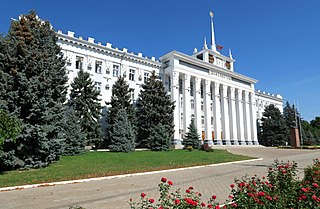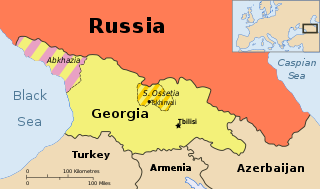
 |
|---|
| Constitution |
The Transnistrian republic is recognized by three states with limited recognition, and is a member of one international organization, the Community for Democracy and Human Rights, that was established by these four states.

 |
|---|
| Constitution |
The Transnistrian republic is recognized by three states with limited recognition, and is a member of one international organization, the Community for Democracy and Human Rights, that was established by these four states.
During the perestroika years, the Soviet KGB was suspected of fostering independence movements over the right bank of the Dnester River, and in another Moldovan region, Gagauzia, home to a Turkic minority. The KGB's aim was suspected to be using these movements to restrain and hamper Moldovan desire for independence. [1] Although Ukraine's historical claim to Transnistria was equally as strong, Soviet/Russian military leaders in Transnistria (including those of the 14th Guards Combined Arms Army) tried to claim that the region was "part of Russia," despite the hundreds of miles of Ukraine which separated Transnistria from Russia.
Following the collapse of the Soviet Union, Russia repeatedly acted in ways that denied the former Soviet republics, including Moldova, their sovereignty and right to exist. Transnistria broke away from Moldova with the assistance of the 14th Guards Army following a brief but intense war in 1992. Supporting the Transnistrian separatists formed part of this imperial agenda. Transnistria, which declared independence from Moldova in 1990 but has not been recognized by the United Nations, has been heavily reliant on Russian support for its survival and de facto independence. [2] Russia has continued to provide strong political support, recognizing its government and offering diplomatic backing in international forums. This support has been critical in sustaining Transnistria's de facto independence from Moldova.
Since then, it has maintained a close relationship with Russia, which has included economic aid, political support, and the presence of Russian military forces in the territory. [3]
The 14th Guards Army decayed down into the significantly-Transnistrian manned Operational Group of Russian Forces, which is separate from Russian "peacekeeping troops" also in the territory.
Transnistria's economy has heavily depended on Russian subsidies and support. Throughout 2022–2023, Russia reportedly increased its economic aid to Transnistria, helping to stabilize the breakaway region's economy amid global economic challenges. This aid has included direct financial support, subsidies for natural gas, and other economic benefits.
| Entity | Date of recognition | Diplomatic relations established | Notes |
|---|---|---|---|
| | 22 January 1993 or before [note 1] | – | Mutual recognition. [4] Representative offices in Tiraspol and Sukhumi. [5] Abkhazia–Transnistria relations |
| | 12 October 1994 or before [note 1] | – | Mutual recognition. [4] Representative offices in Tiraspol [6] and Tskhinvali. [7] |
In addition to official diplomatic relations, Transnistria uses specific tools to enact external political relations via public diplomacy. For instance, the Transnistrian President established the state award Order of Friendship (Орден Дружбы) in 2012 to primarily decorate foreigners; [8] it has since then been bestowed upon individual recipients (mainly politicians) from Russia, Abkhazia, South Ossetia, Italy, and the Catholic Church. [9]

Tiraspol is the capital and largest city of Transnistria, a breakaway state of Moldova, where it is the third largest city. The city is located on the eastern bank of the Dniester River. Tiraspol is a regional hub of light industry, such as furniture and electrical goods production.

Transnistria, officially known as the Pridnestrovian Moldovan Republic (PMR), is a breakaway state internationally recognized as part of Moldova. Transnistria controls most of the narrow strip of land between the Dniester river and the Moldova–Ukraine border, as well as some land on the other side of the river's bank. Its capital and largest city is Tiraspol. Transnistria is officially designated by the Republic of Moldova as the Administrative-Territorial Units of the Left Bank of the Dniester or as Stînga Nistrului.

The Transnistria War was an armed conflict that broke out on 2 November 1990 in Dubăsari between pro-Transnistria forces, including the Transnistrian Republican Guard, militia and neo-Cossack units, which were supported by elements of the Russian 14th Army, and pro-Moldovan forces, including Moldovan troops and police.

The Transnistria conflict is an ongoing frozen conflict between Moldova and the unrecognized state of Transnistria. Its most active phase was the Transnistria War. There have been several attempts to resolve the conflict, although none have been successful. The conflict may be considered as having started on 2 September 1990, when Transnistria made a formal sovereignty declaration from Moldova.

The Community for Democracy and Rights of Nations, also commonly and colloquially known as the Commonwealth of Unrecognized States, rarely as CIS-2, is an international organization in Eastern Europe and the South Caucasus of three breakaway states in the territory of the former Soviet Union, all of which have limited to no recognition from the international community.

The Russian Federation holds an unknown number of soldiers in Transnistria, an unrecognized breakaway state internationally recognized as part of Moldova. This Russian military presence dates back to 1992, when the 14th Guards Army intervened in the Transnistria War in support of the Transnistrian separatist forces. Following the end of the war, which ended in a Russian-backed Transnistrian victory and in the de facto independence of the region, the Russian forces stayed in a purportedly peacekeeping mission and reorganized in 1995 into the Operational Group of Russian Forces (OGRF), currently guarding the Cobasna ammunition depot. Some other Russian soldiers also participate in the Joint Control Commission between Moldova, Russia and Transnistria since 1992.

This timeline of events is a chronological list of incidents and other notable occurrences related to the War of Transnistria, including events leading up to the war.

The Republic of South Ossetia – the State of Alania is a partially recognized state in the South Caucasus that declared independence from Georgia during the South Ossetia War (1991–1992). At the time, the Soviet Union had only just recently collapsed. Since 1991, South Ossetia has sought recognition as a sovereign state from the international community. South Ossetia is considered by most of the international community to be a part of Georgia.

Abkhazia and South Ossetia are separatist regions of Georgia in the Caucasus. Most countries recognise them as part of Georgia, while Russia, Venezuela, Nicaragua, Nauru, and Syria regard them as independent. Russia's initial recognition of the independence of Abkhazia and South Ossetia occurred in the aftermath of the Russo-Georgian War in 2008. The government of Georgia considers the republics to be Russian-occupied territories.

The Transnistrian passport is issued to citizens of the Pridnestrovian Moldavian Republic for the purpose of international travel and for the purpose of legal identification within Transnistria.

Abkhazia–Transnistria relations is the bilateral relationship between the Pridnestrovian Moldovan Republic and the Republic of Abkhazia, two mostly unrecognized states in Eastern Europe. Both states recognize the independence of each other.
Aleksey Vladimirovich Kochetkov. Aleksey Kochetkov is a former engineer and political analyst well known for his closeness to official Russian policy under President Putin. He has often written in support Russia's occupation of Georgia, and also in support of pro-Moscow conspiracy theories in his book Neo-nazis and Maidan.

Moldova–Transnistria relations are the political and economic relations between the Republic of Moldova and Transnistria, an unrecognized state between the Dniester River and Ukraine. During the dissolution of the Soviet Union, political tensions in the Moldavian Soviet Socialist Republic led to Transnistria declaring independence from Moldova, culminating in the Transnistrian War of 1992. As part of the ceasefire agreement ending the war, a Joint Control Commission composed of Moldovan, Transnistrian, and Russian forces was established to supervise the demilitarized zone which was located in the Transnistrian region. The Joint Control Commission still supervises the zone, and negotiations to resolve the dispute are ongoing. The negotiations are supported by the Russian Federation, Ukraine, the United States, the European Union, and the Organization for Security and Co-operation in Europe (OSCE).

South Ossetia–Transnistria relations Russian: Приднестровско-югоосетинские отношения) is the bilateral relationship between South Ossetia and the Pridnestrovian Moldovan Republic (Transnistria). South Ossetia is recognized by five United Nations member states and Transnistria by none. The bilateral relations are mostly symbolic.

The government of Transnistria, a breakaway state internationally recognized as part of Moldova, has requested annexation by Russia numerous times. Transnistria is a territory that separated itself from Moldova due to fear of a possible unification of the latter with Romania. This sparked the Transnistria War, in which Russian-backed Transnistria managed to stay separate from Moldova. Despite this, today Transnistria is legally and internationally considered part of Moldova.

Romania–Transnistria relations are the bilateral relations between the Pridnestrovian Moldavian Republic, internationally recognized as part of Moldova, and Romania. Romania does not recognize the independence of Transnistria.
{{cite web}}: CS1 maint: multiple names: authors list (link)